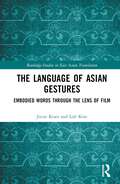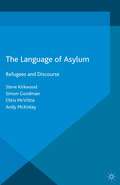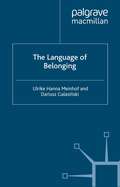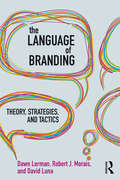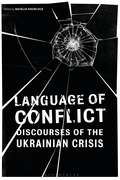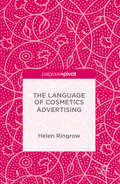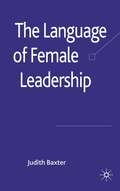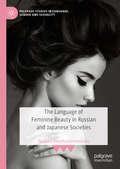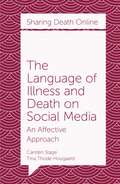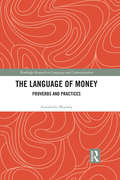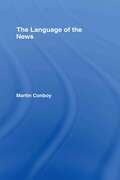- Table View
- List View
The Language of Asian Gestures: Embodied Words Through the Lens of Film (Routledge Studies in East Asian Translation)
by Jieun Kiaer Loli KimThe Language of Asian Gestures explores Asian gestures as a non-verbal language within the context of films and dramas.This book provides a cross-cultural Asian perspective on a range of important common gestures and their meanings, covering a range of Asian regions including Korea, China, Hong Kong, Japan, Taiwan, Vietnam, Singapore, Thailand, Indonesia, the Philippines, India, and Pakistan. While most studies focus on text-based communication, gestures find themselves overshadowed by text and speech. Asian gestures, too, often reside in the shadow of Eurocentric viewpoints. This book will shift this dynamic and amplify the voices that have typically been marginalised within 20th-century Eurocentric discussions.The book will be informative for students and researchers interested in Asian languages, cultures, film studies, and pragmatics. It bridges the gap between words and gestures, unveiling a world of concealed meanings and enriching our understanding of diverse forms of expression.
The Language of Asylum: Refugees and Discourse
by Simon Goodman Chris McVittie Andy McKinlay Steven KirkwoodThe early part of the 21st century has been marked by widespread social upheaval and geographical displacement of people. This book examines how refugees, asylum-seekers, locals and professional refugee workers make sense of asylum and refuge in the context of current UK asylum policies.
The Language of Belonging (Language and Globalization)
by U. Meinhof D. GalasinskiThis examines a significant aspect of contemporary social life: cultural identities and our linguistic means of constructing them. It combines a theoretical re-assessment of processes of identification with case studies of the discourses of three-generation families living in split-border communities along the former 'Iron Curtain'.
The Language of Branding: Theory, Strategies, and Tactics
by Dawn Lerman Robert J. Morais David LunaThe Language of Branding: Theory, Strategies and Tactics shows marketers how to use language successfully to improve brand value and influence consumer behavior. Luna and Lerman are among only a few researchers who take a multidisciplinary perspective on the ways language influences how consumers act. Together with Morais, an anthropologist engaged in market research, they show how understanding the power of language can impact the essence – and sales – of a brand. The book covers the fundamentals of brand language and applications for an array of marketing initiatives. Readers will learn why brand language matters, how language is used in marketing, and how to build a brand strategy that capitalizes on the richness and complexity of language. This book includes real-world case histories that demonstrate vividly how brand language is created and exercises that enable both students of marketing and marketing professionals to apply the book’s concepts and stimulate class discussion. The Language of Branding: Theory, Strategies and Tactics can be used in a number of courses, including consumer behavior, branding, advertising, linguistics, and communications.
The Language of Branding: Theory, Strategies, and Tactics
by Dawn Lerman Robert J. Morais David LunaThe Language of Branding: Theory, Strategies and Tactics shows marketers how to use language successfully to improve brand value and influence consumer behavior. Luna and Lerman are among only a few researchers who take a multidisciplinary perspective on the ways language influences how consumers act. Together with Morais, an anthropologist engaged in market research, they show how understanding the power of language can impact the essence – and sales – of a brand. The book covers the fundamentals of brand language and applications for an array of marketing initiatives. Readers will learn why brand language matters, how language is used in marketing, and how to build a brand strategy that capitalizes on the richness and complexity of language. This book includes real-world case histories that demonstrate vividly how brand language is created and exercises that enable both students of marketing and marketing professionals to apply the book’s concepts and stimulate class discussion. The Language of Branding: Theory, Strategies and Tactics can be used in a number of courses, including consumer behavior, branding, advertising, linguistics, and communications.
Language of Conflict: Discourses of the Ukrainian Crisis
by Natalia KnoblockExploring the ways in which language and conflict are intertwined and interrelated, this volume examines the patterns of public discourse in Ukraine and Russia since the beginning of the Ukrainian Crisis in 2014. It investigates the trends in language aggression, evaluation, persuasion and other elements of conflict communication related to the situation. Through the analysis of the linguistic features of salient discourses and prevalent narratives constructed by different social groups, Language of Conflict reflects competing worldviews of various stakeholders in this conflict and presents multiple, often contradictory, visions of the circumstances. Contributors from Ukraine, Russia and beyond investigate discursive representations of the most important aspects of the crisis: its causes and goals, participant andthe values and ideologies of the opposing factions. They focus on categorization, stance, framing, (de)legitimation, manipulation and coping strategies while analysing the ways in which the stress produced by social discord, economic hardship, and violence shapes public discourse. Primarily focusing on informal communication and material gathered from online sources, the collection provides insight into the ways people directly affected by the crisis think about and respond to it. The volume acknowledges the communicators' active role in constructing the (often incompatible) discursive images of the conflict and concentrates on the conscious and strategic use of linguistic resources in negative and aggressive communication.
Language of Conflict: Discourses of the Ukrainian Crisis
Exploring the ways in which language and conflict are intertwined and interrelated, this volume examines the patterns of public discourse in Ukraine and Russia since the beginning of the Ukrainian Crisis in 2014. It investigates the trends in language aggression, evaluation, persuasion and other elements of conflict communication related to the situation. Through the analysis of the linguistic features of salient discourses and prevalent narratives constructed by different social groups, Language of Conflict reflects competing worldviews of various stakeholders in this conflict and presents multiple, often contradictory, visions of the circumstances. Contributors from Ukraine, Russia and beyond investigate discursive representations of the most important aspects of the crisis: its causes and goals, participant andthe values and ideologies of the opposing factions. They focus on categorization, stance, framing, (de)legitimation, manipulation and coping strategies while analysing the ways in which the stress produced by social discord, economic hardship, and violence shapes public discourse. Primarily focusing on informal communication and material gathered from online sources, the collection provides insight into the ways people directly affected by the crisis think about and respond to it. The volume acknowledges the communicators' active role in constructing the (often incompatible) discursive images of the conflict and concentrates on the conscious and strategic use of linguistic resources in negative and aggressive communication.
The Language of Cosmetics Advertising
by Helen RingrowThis book offers a cross-cultural comparison of French and British cosmetics advertisements and explores how the discourse of beauty advertising represents ideas about femininity in French and English language contexts. As the global beauty industry expands and consumers become more critical of the claims made, the topic of cosmetics advertising discourse is examined using Feminist Critical Discourse Analysis. One common theme underlying most cosmetics advertising discourse is that the female body always requires ‘work’ to fix its ‘problems’: flat skin, dry hair, and so on. The author uses themes of language and gender, media and identity, and advertising across cultures to expose exactly what is going on in the language of cosmetics advertising and to offer a first step towards challenging these ideas and thinking about alternatives.
The Language of Fear: Communicating Threat in Public Discourse
by Piotr CapThis book investigates linguistic strategies of threat construction and fear generation in contemporary public communication, including state political discourse as well as non-governmental, media and institutional discourses. It describes the ways in which the construction of closeness and remoteness can be manipulated in the public sphere and bound up with fear, security and conflict. Featuring a series of case studies in different domains, from presidential speeches to environmental discourse, it demonstrates how political and organizational leaders enforce the imminence of an outside threat to claim legitimization of preventive policies. It reveals that the best legitimization effects are obtained by discursively constructed fear appeals, which ensure quick social mobilization. The scope of the book is of immediate concern in the modern globalized era where borders and distance dissolve and are re-imagined. It will appeal to students and researchers in linguistics, discourse analysis, media communication as well as social and political sciences.
The Language of Female Leadership
by J. BaxterCould language be a reason why women are under-represented at senior level in the business world? Using data from senior management meetings, this book explores how female leaders use language to achieve their business and relational goals by arguing that senior women have to develop linguistic expertise in order to be effective leaders.
The Language of Feminine Beauty in Russian and Japanese Societies (Palgrave Studies in Language, Gender and Sexuality)
by Natalia KonstantinovskaiaThis book conducts a cross-linguistic and cross-cultural study of 'women’s language' as it pertains to feminine beauty. It examines the ideological constructs of beauty and femininity in the cultures of Japan and Russia, as embodied through televised beauty ads, and relates them to the real-world language practices of Japanese and Russian women. The author traces the reciprocal connection between women’s real and imagined language in the construction of ideals of beauty and femininity, revealing the complex ways women respond to ideological expectations regarding language use: assimilating, transforming, and subverting ideologized language and the assumptions implicit in it. She also demonstrates ways in which women alter the texture of language by appropriating 'masculine' language for their own purposes, shifting the meaning and correlates of linguistic items and structures. This book will be of interest to students and scholars of sociolinguistics, language and gender, cultural and media studies, and Russian and Japanese culture.
The Language of Global Success: How a Common Tongue Transforms Multinational Organizations
by Tsedal NeeleyFor nearly three decades, English has been the lingua franca of cross-border organizations, yet studies on corporate language strategies and their importance for globalization have been scarce. In The Language of Global Success, Tsedal Neeley provides an in-depth look at a single organization—the high-tech giant Rakuten—in the five years following its English lingua franca mandate. Neeley’s behind-the-scenes account explores how language shapes the ways in which employees who work in global organizations communicate and negotiate linguistic and cultural differences.Drawing on 650 interviews conducted across Rakuten’s locations in Brazil, France, Germany, Indonesia, Japan, Taiwan, Thailand, and the United States, Neeley argues that an organization’s lingua franca is the catalyst by which all employees become some kind of “expat”—someone detached from their mother tongue or home culture. Through her unfettered access to the inner workings of Rakuten, she reveals three distinct social groups: “linguistic expats,” who live in their home country yet have to give up their native language in the workplace; “cultural expats,” or native speakers of the lingua franca, who struggle with organizational values that are more easily transmitted after language barriers are removed; and finally “linguistic-cultural expats,” who, while native to neither the lingua franca nor the organization’s home culture, surprisingly have the easiest time adjusting to language changes. Neeley demonstrates that language can serve as the conduit for an unfamiliar culture, often in unexpected ways, and that there are lessons to be learned for all global companies as they confront language and culture challenges.Examining the strategic use of language by one international corporation, The Language of Global Success uncovers how all organizations might integrate language effectively to tap into the promise of globalization.
The Language of Global Success: How a Common Tongue Transforms Multinational Organizations
by Tsedal NeeleyFor nearly three decades, English has been the lingua franca of cross-border organizations, yet studies on corporate language strategies and their importance for globalization have been scarce. In The Language of Global Success, Tsedal Neeley provides an in-depth look at a single organization—the high-tech giant Rakuten—in the five years following its English lingua franca mandate. Neeley’s behind-the-scenes account explores how language shapes the ways in which employees who work in global organizations communicate and negotiate linguistic and cultural differences.Drawing on 650 interviews conducted across Rakuten’s locations in Brazil, France, Germany, Indonesia, Japan, Taiwan, Thailand, and the United States, Neeley argues that an organization’s lingua franca is the catalyst by which all employees become some kind of “expat”—someone detached from their mother tongue or home culture. Through her unfettered access to the inner workings of Rakuten, she reveals three distinct social groups: “linguistic expats,” who live in their home country yet have to give up their native language in the workplace; “cultural expats,” or native speakers of the lingua franca, who struggle with organizational values that are more easily transmitted after language barriers are removed; and finally “linguistic-cultural expats,” who, while native to neither the lingua franca nor the organization’s home culture, surprisingly have the easiest time adjusting to language changes. Neeley demonstrates that language can serve as the conduit for an unfamiliar culture, often in unexpected ways, and that there are lessons to be learned for all global companies as they confront language and culture challenges.Examining the strategic use of language by one international corporation, The Language of Global Success uncovers how all organizations might integrate language effectively to tap into the promise of globalization.
The Language of Illness and Death on Social Media: An Affective Approach (Sharing Death Online)
by Carsten Stage Tina Thode HougaardThis book investigates the language created and used on social media to express and respond to personal experiences of illness, dying and mourning. The authors begin by setting out the established and recent research on social and existential media, affect and language, before focusing on Facebook groups dealing with the illness and death of two Danish children. Through these in-depth case studies, they produce insights into different ways of engaging in affective processes related to illness and death on social media, and into both the ritualized and innovative vernacular vocabulary created through these encounters. Developing an analytical framework for understanding the social role and logics of "affective language" (such as emojis, interjections and other forms of expressive interactive writing), The Language of Illness and Death on Social Media will be of great interest to all those striving to understand the affective importance and roles of language for sharing experiences of illness, death and commemoration in these spheres.
The Language of Journalism: Volume 1, Newspaper Culture (Language Of Journalism Ser.)
by Melvin J. LaskyThe newspaper is to the twentieth century what the novel was for the nineteenth century: the expression of popular sentiment. In the first of a three-volume study of journalism and what it has meant as a source of knowledge and as a mechanism for orchestrating mass ideology, Melvin J. Lasky provides a major overview. His research runs the gamut of material found in newspapers, from the trivial to the profound, from pseudo-science to habits of solid investigation.The volume is divided into four parts. The first attacks deficiencies in grammar and syntax with examples from newspapers and magazines drawn from the German as well as English-language press. The second examines the key issues of journalism: accuracy and authenticity. Lasky provides an especially acute account of differences between active literacy and passive viewing, or the relationship of word and picture in defining authenticity.The third part emphasizes the problem of bias in everything from racial reporting to cultural correctness. This is the first systematic attempt to study racial nomenclature, identity-labeling, and literary discrimination. Lasky follows closely the model set by George Orwell a half century earlier. The final section of the work covers the competition between popular media and the redefinition of pornography and its language. The volume closes with an examination of how the popular culture both influenced and was influential upon literary titans like Hemingway, Lawrence, and Tynan.
The Language of Journalism: Volume 1, Newspaper Culture
by Melvin J. LaskyThe newspaper is to the twentieth century what the novel was for the nineteenth century: the expression of popular sentiment. In the first of a three-volume study of journalism and what it has meant as a source of knowledge and as a mechanism for orchestrating mass ideology, Melvin J. Lasky provides a major overview. His research runs the gamut of material found in newspapers, from the trivial to the profound, from pseudo-science to habits of solid investigation.The volume is divided into four parts. The first attacks deficiencies in grammar and syntax with examples from newspapers and magazines drawn from the German as well as English-language press. The second examines the key issues of journalism: accuracy and authenticity. Lasky provides an especially acute account of differences between active literacy and passive viewing, or the relationship of word and picture in defining authenticity.The third part emphasizes the problem of bias in everything from racial reporting to cultural correctness. This is the first systematic attempt to study racial nomenclature, identity-labeling, and literary discrimination. Lasky follows closely the model set by George Orwell a half century earlier. The final section of the work covers the competition between popular media and the redefinition of pornography and its language. The volume closes with an examination of how the popular culture both influenced and was influential upon literary titans like Hemingway, Lawrence, and Tynan.
The Language of Mediums and Psychics: The Social Organization of Everyday Miracles
by Robin WooffittEvery week thousands of people in Europe and the USA consult psychic practitioners. Communication is crucial to the performance of psychic powers in a range of settings. Psychic practitioners use language to demonstrate their powers, whether they are reporting the words of their spirit contacts or interpreting the spread of Tarot cards. Their clients also accept or reject this information through talk. This book presents the first sustained study of the verbal interaction between the various kinds of psychic practitioners and their clients. Using conversation analysis, Robin Wooffitt examines the structure of the interaction, focusing on the ways in which psychic practitioners and their clients establish the authenticity of the claimed paranormal powers. Adopting a neutral standpoint towards the status of the claims of psychic practitioners, the book raises important issues about the role of social science in understanding the activities of psychic practitioners and other kinds of parapsychological phenomena. This highly original study will appeal to students and scholars of discourse studies, and to sociologists interested in conversation analysis. It is written in a style accessible to non-specialists, and will also interest parapsychologists and social scientists studying psychic phenomena and the paranormal.
The Language of Mediums and Psychics: The Social Organization of Everyday Miracles
by Robin WooffittEvery week thousands of people in Europe and the USA consult psychic practitioners. Communication is crucial to the performance of psychic powers in a range of settings. Psychic practitioners use language to demonstrate their powers, whether they are reporting the words of their spirit contacts or interpreting the spread of Tarot cards. Their clients also accept or reject this information through talk. This book presents the first sustained study of the verbal interaction between the various kinds of psychic practitioners and their clients. Using conversation analysis, Robin Wooffitt examines the structure of the interaction, focusing on the ways in which psychic practitioners and their clients establish the authenticity of the claimed paranormal powers. Adopting a neutral standpoint towards the status of the claims of psychic practitioners, the book raises important issues about the role of social science in understanding the activities of psychic practitioners and other kinds of parapsychological phenomena. This highly original study will appeal to students and scholars of discourse studies, and to sociologists interested in conversation analysis. It is written in a style accessible to non-specialists, and will also interest parapsychologists and social scientists studying psychic phenomena and the paranormal.
The Language of Money: Proverbs and Practices (Routledge Research in Language and Communication)
by Annabelle MooneyThrough a detailed examination of proverbs related to money, this book offers a comprehensive critique of the prevailing everyday ideologies and discourses on money and paves the way toward establishing a new set of proverbs more conducive to financial equality and human well-being. The volume explores a variety of contexts to demonstrate the different aspects of the money system and the linguistic and social structures embedded within them, including pay day loan websites, gambling, get rich self-help books, and new forms of currency. Unpacking this complex relationship between people, money, and language in contemporary society, this book is an ideal resource for students and scholars in language and communication, sociolinguistics, rhetoric, sociology, and media studies.
The Language of Money: Proverbs and Practices (Routledge Research in Language and Communication)
by Annabelle MooneyThrough a detailed examination of proverbs related to money, this book offers a comprehensive critique of the prevailing everyday ideologies and discourses on money and paves the way toward establishing a new set of proverbs more conducive to financial equality and human well-being. The volume explores a variety of contexts to demonstrate the different aspects of the money system and the linguistic and social structures embedded within them, including pay day loan websites, gambling, get rich self-help books, and new forms of currency. Unpacking this complex relationship between people, money, and language in contemporary society, this book is an ideal resource for students and scholars in language and communication, sociolinguistics, rhetoric, sociology, and media studies.
The Language of Persuasion in Politics: An Introduction
by Charlotte Taylor Alan PartingtonThis accessible introductory textbook looks at the modern relationship between politicians, the press and the public through the language they employ, with extensive coverage of key topics including: ‘spin’, ‘spin control’ and ‘image’ politics models of persuasion: authority, contrast, association pseudo-logical and ‘post-truth’ arguments political interviewing: difficult questions, difficult answers metaphors and metonymy rhetorical figures humour, irony and satire Extracts from speeches, soundbites, newspapers and blogs, interviews, press conferences, election slogans, social media and satires are used to provide the reader with the tools to discover the beliefs, character and hidden strategies of the would-be persuader, as well as the counter-strategies of their targets. This book demonstrates how the study of language use can help us appreciate, exploit and protect ourselves from the art of persuasion. With a wide variety of practical examples on both recent issues and historically significant ones, every topic is complemented with guiding tasks, queries and exercises with keys and commentaries at the end of each unit. This is the ideal textbook for all introductory courses on language and politics, media language, rhetoric and persuasion, discourse studies and related areas.
The Language of Persuasion in Politics: An Introduction
by Charlotte Taylor Alan PartingtonThis accessible introductory textbook looks at the modern relationship between politicians, the press and the public through the language they employ, with extensive coverage of key topics including: ‘spin’, ‘spin control’ and ‘image’ politics models of persuasion: authority, contrast, association pseudo-logical and ‘post-truth’ arguments political interviewing: difficult questions, difficult answers metaphors and metonymy rhetorical figures humour, irony and satire Extracts from speeches, soundbites, newspapers and blogs, interviews, press conferences, election slogans, social media and satires are used to provide the reader with the tools to discover the beliefs, character and hidden strategies of the would-be persuader, as well as the counter-strategies of their targets. This book demonstrates how the study of language use can help us appreciate, exploit and protect ourselves from the art of persuasion. With a wide variety of practical examples on both recent issues and historically significant ones, every topic is complemented with guiding tasks, queries and exercises with keys and commentaries at the end of each unit. This is the ideal textbook for all introductory courses on language and politics, media language, rhetoric and persuasion, discourse studies and related areas.
The Language of the Game: How to Understand Soccer
by Laurent DuboisEssential reading for soccer fans amid the Women's World Cup in 2019, a lively and lyrical guide to appreciating the drama of soccer Soccer is not only the world's most popular sport; it's also one of the most widely shared forms of global culture. The Language of the Game is a passionate and engaging introduction to soccer's history, tactics, and human drama. Profiling soccer's full cast of characters -- goalies and position players, referees and managers, commentators and fans -- historian and soccer scholar Laurent Dubois describes how the game's low scores, relentless motion, and spectacular individual performances combine to turn each match into a unique and unpredictable story. He also shows how soccer's global reach makes it an unparalleled theater for nationalism, international conflict, and human interconnectedness, with close attention to both men's and women's soccer.Filled with perceptive insights and stories both legendary and little known, The Language of the Game is a rewarding read for anyone seeking to understand soccer better -- newcomers and passionate followers alike.
The Language Of The News
by Martin ConboyThe Language of the News investigates and critiques the conventions of language used in newspapers and provides students with a clear introduction to critical linguistics as a tool for analysis. Using contemporary examples from UK, USA and Australian newspapers, this book deals with key themes of representation – from gender and national identity to ‘race’– and looks at how language is used to construct audiences, to persuade, and even to parody. It examines debates in the newspapers themselves about the nature of language including commentary on political correctness, the sensitive use of language and irony as a journalistic weapon. Featuring chapter openings and summaries, activities, and a wealth of examples from contemporary news coverage (including examples from television and radio), The Language of the News broadens the perceptions of the use of language in the news media and is essential reading for students of media and communication, journalism, and English language and linguistics.
